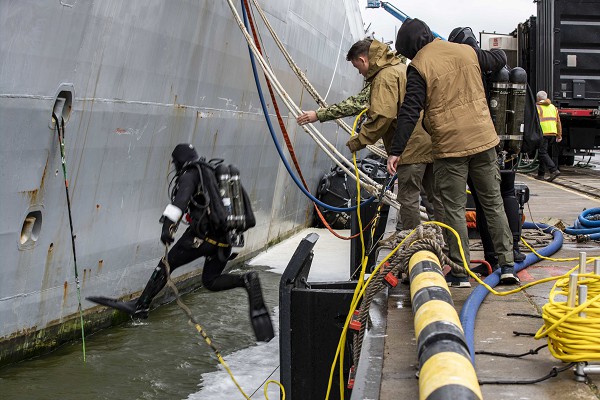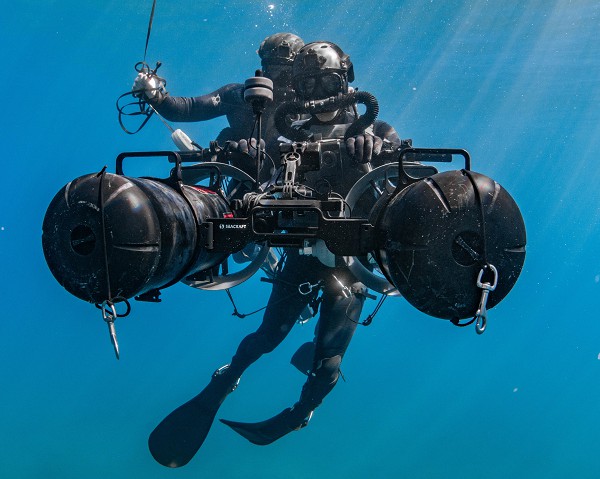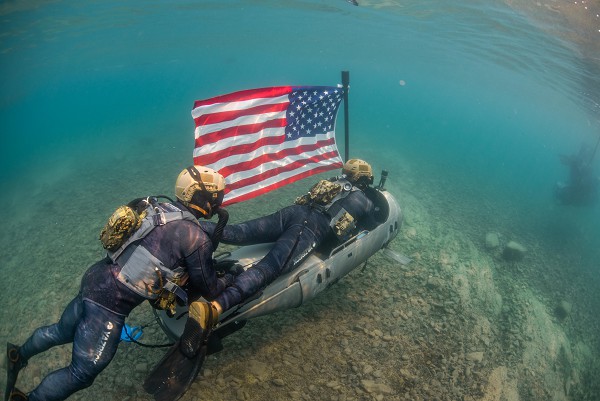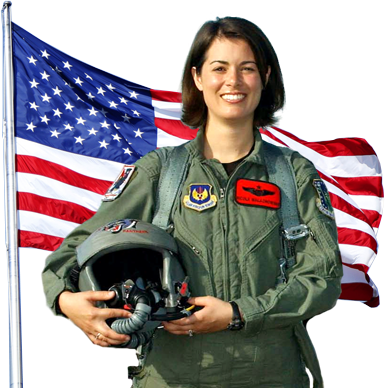- Details
- Hits: 6027
 Virginia Beach, VA. (November 30, 2022): In this photo by MC3 Megan Wollam, an FG-1D Corsair, flown by Mike Spalding, Chief Pilot at the Military Aviation Museum, taxis after a heritage flight with Strike Fighter Squadron 103 onboard Naval Air Station Oceana. The Corsair was once assigned to the famous “Jolly Rogers” Fighter Squadron VF-17 in 1943 and shares the same call sign. These flying buccaneers downed 154 Japanese airplanes in just 76 days of combat earning them the grudging respect of their enemy who called them “Whispering Death”.
Virginia Beach, VA. (November 30, 2022): In this photo by MC3 Megan Wollam, an FG-1D Corsair, flown by Mike Spalding, Chief Pilot at the Military Aviation Museum, taxis after a heritage flight with Strike Fighter Squadron 103 onboard Naval Air Station Oceana. The Corsair was once assigned to the famous “Jolly Rogers” Fighter Squadron VF-17 in 1943 and shares the same call sign. These flying buccaneers downed 154 Japanese airplanes in just 76 days of combat earning them the grudging respect of their enemy who called them “Whispering Death”.
Virginia Beach, VA. (November 30, 2022): Their symbol was the pirate’s skull and crossbones, and Japanese pilots called them “Whispering Death. The Navy’s Jolly Rogers squadron terrorized the enemy during World War II and continues to intimidate America’s adversaries to this day.The story of the Jolly Rogers begins in 1943 as the Navy adopted the Vought F4U Corsair fighter as a trainer for new pilots preparing for combat in World War II. While an excellent airplane for training, the Corsair was difficult to fly, particularly off an aircraft carrier. The Navy decided to deploy the Corsair in land-based squadrons in the Pacific Solomon Islands and, as they say, the rest is history.
Led by Commander Tom Blackburn, the pilots of Navy Squadron VF-17 wanted an emblem to paint on their fuselages that matched their name, Corsair or pirate, hence the adoption of the famous white skull and crossbones on a black background as the squadron’s symbol. Their name, Jolly Rogers completed the pirate theme.
Commander Blackburn, unlike many stodgy Navy leaders of the time, did not discourage the somewhat unruly behavior of his pilots as he wanted men who were fearless for the job at hand.
Like their swashbuckling namesake, the Jolly Rogers scored the highest number of enemy kills of any such Navy unit during the war, even exceeding the better-known Marines “Black Sheep” squadron commanded by “Pappy Boyington” whose exploits were later celebrated in a popular T.V. show. In all, Navy Squadron VF-17 downed 154 Japanese airplanes in just 76 days of combat earning them the grudging respect of their enemy who called them “Whispering Death”.
The Jolly Rogers live on as Strike Fighter Squadron 103 located onboard Naval Air Station Oceana in Virginia Beach, Virginia and they are flying the Navy’s newest strike fighter the F/A-18 Super Hornet. The squadron’s call sign is “Victory,” and they remain an intimidating force for America’s enemies.
It takes great skill and courage to pilot high performance aircraft in combat and we at Support Our Troops salute these brave aviators. Our mission is to provide these servicemembers with “what they need, where they need it” through our Yellow Ribbon Care Packages and the recreational opportunities we provide for deployed troops. You can do your part by contributing to our Patriots Brigade to help send comfort items to boost their spirits during the holidays? Please visit our secure website https://supportourtroops.org/donate to donate to America’s finest today!
- Details
- Hits: 963
 Klaipeda, Lithuania (November 19, 2022): In this photo by MC1 John Bellino, U.S. Navy Diver 1st Class William Crampton, left, assigned to Forward Deployed Regional Maintenance Center, Bahrain, enters the water to conduct underwater maintenance on the San Antonio-class amphibious transport dock ship USS Arlington during a scheduled port visit. The Arlington is part of the Kearsarge Amphibious Ready Group and 22nd Marine Expeditionary Unit, under the command and control of Task Force 61/2, is on a scheduled deployment in the U.S. Naval Forces Europe area of operations, employed by U.S. Sixth Fleet to defend U.S., allied and partner interests.
Klaipeda, Lithuania (November 19, 2022): In this photo by MC1 John Bellino, U.S. Navy Diver 1st Class William Crampton, left, assigned to Forward Deployed Regional Maintenance Center, Bahrain, enters the water to conduct underwater maintenance on the San Antonio-class amphibious transport dock ship USS Arlington during a scheduled port visit. The Arlington is part of the Kearsarge Amphibious Ready Group and 22nd Marine Expeditionary Unit, under the command and control of Task Force 61/2, is on a scheduled deployment in the U.S. Naval Forces Europe area of operations, employed by U.S. Sixth Fleet to defend U.S., allied and partner interests.
Klaipeda, Lithuania (November 19, 2022): A Navy warship has hit a mine and is limping towards port as the crew struggles to keep the vessel and crew afloat. Waiting for them are some of the world’s most experienced and skillful divers in the world ready to tackle any type of underwater repair needed to save the ship and crew.
These scuba divers are called upon to handle wartime situations like these and many more.
Navy divers perform their duties in port and in the open ocean using all manner of underwater breathing devices, from the traditional SCUBA to mixed gas breathing apparatus for deep water dives. Their primary role is salvage operations in waters up to 300 feet deep and their duties range from recovering entire ships to retrieving debris spread over miles of ocean floor. In dealing with battle damage, these professionals perform highly complex underwater repairs to surface ships and submarines that are essential to keeping the fleet operational. They wear state of the art diving equipment to perform underwater cutting and welding tasks using hydraulic tool systems requiring skill and accuracy to operate. From constructing watertight enclosures to prevent flooding to replacing 80-ton ships anchors, if it is under the water line, Navy divers can handle it.
Read more: IF ITS BELOW THE WATER LINE… NAVY DIVERS CAN HANDLE IT
- Details
- Hits: 1016
 CAMP ARIFJAN, Kuwait (November 18, 2022): Specialist Cesar Rodriquez, a diver with the 7th Engineer Diver Detachment, receives instructions from a diving supervisor before leaving the surface during an annual salvage diver training exercise at Kuwait Naval Base.
CAMP ARIFJAN, Kuwait (November 18, 2022): Specialist Cesar Rodriquez, a diver with the 7th Engineer Diver Detachment, receives instructions from a diving supervisor before leaving the surface during an annual salvage diver training exercise at Kuwait Naval Base.
CAMP ARIFJAN, Kuwait (November 18, 2022): When one thinks of military divers, images of Navy or Coast Guard ships come immediately to mind. What most American’s don’t realize is that the U.S. Army has divers too, and for unique reasons.
The U.S. Army Special Forces Underwater Operations School, run by the 1st Special Warfare Training Group (Airborne), trains more than 300 servicemembers a year and offers three separate courses: Combat Dive Qualification, Combat Diving Supervisor, and Diving Medical Technician. The School prepares elite Army Green Berets for insertion missions into and out of enemy territory that includes exiting submarines. The basic certification course is a rigorous six-week program that tests the physical and mental capability of candidates to maximum.
Unlike Navy salvage divers, these Green Berets view combat dives as a means to insert themselves undetected into threat areas rather than conducting routine maintenance. Army Combat divers are often called upon to work with Ranger battalions during high risk missions behind enemy lines making them the cream of America’s Special Forces.
- Details
- Hits: 1223
 NORTHERN CALIFORNIA (Sept. 5, 2022) In this photo by MC2 Alex Perlman, Sailors assigned to various Naval Special Warfare (NSW) commands operate a Diver Propulsion Device (DPD) during high-altitude dive training. These devices allow combat divers to travel faster, and farther, underwater making them less fatigued when reaching their destination. The DPD greatly expands the speed and range of Navy divers during special operations missions.
NORTHERN CALIFORNIA (Sept. 5, 2022) In this photo by MC2 Alex Perlman, Sailors assigned to various Naval Special Warfare (NSW) commands operate a Diver Propulsion Device (DPD) during high-altitude dive training. These devices allow combat divers to travel faster, and farther, underwater making them less fatigued when reaching their destination. The DPD greatly expands the speed and range of Navy divers during special operations missions.
NORTHERN CALIFORNIA (Sept. 5, 2022): If you have ever gone swimming with fins on your feet, you know how difficult and tiring travelling underwater can be. For Navy divers on a combat mission, the ability to move quickly and travel long distances is essential. Luckily, our nations combat divers have Diver Propulsion Devices (DPD’s) that allow them to travel faster and farther than when moving under their own power.
Depending on the mission or environmental conditions, Navy divers have several choices in terms of range, speed, and payload capacity with today’s NDPs. Often called “underwater scooters”, these battery-operated units have dual thrusters and, depending upon the model, can transport two or more divers great distances while carrying various payloads.
A prime tool for Navy SEALs, USMC, Force Recon and Army Special Forces SCUBA teams, the DPS is employed as an insertion platform for combat divers to travel long distances while remaining undetected by the enemy. Manufactured by STIDD Systems, Inc., these devices feature hard coat hulls made from marine grade aluminum making them light and highly portable once on land. These DPDs can operate down to 100 feet below the surface and have a range of up to 7 miles traveling at an average speed of 1.2 knots.
- Details
- Hits: 998
 Pearl Harbor, HI. (July 21, 2022): In this photo by Navy Chief Eric Chan, a U.S. Navy diver and a Mexican navy diver participate in underwater construction activities as part Rim of the Pacific exercises involving 26 nations which is the largest maritime training event held each year. The Navy’s Mobile Diving Salvage Unit 2, which normally operates in warm, deep-water environments, is training for underwater missions in the frozen Arctic.
Pearl Harbor, HI. (July 21, 2022): In this photo by Navy Chief Eric Chan, a U.S. Navy diver and a Mexican navy diver participate in underwater construction activities as part Rim of the Pacific exercises involving 26 nations which is the largest maritime training event held each year. The Navy’s Mobile Diving Salvage Unit 2, which normally operates in warm, deep-water environments, is training for underwater missions in the frozen Arctic.
Camp Ripley, MN. (November 22, 2022): As our adversaries expand their activities in the frozen north, America’s armed forces are refocusing efforts at training to fight, and win, in Arctic conditions. Normally deep-sea divers, America’s Mobile Diving Salvage Unit 2 (MDSU2) are learning to survive and thrive in the icy waters of Minnesota while testing themselves, and their equipment, in some of the most hostile environments known to man.
Camp Ripley is located near Little Falls, Minnesota on a 53,000-acre training center that is now home to Coast Guard and Navy divers training to operate both above and below the ice of its many frozen deep-water lakes. The ice diving training is part of the Navy’s Strategic Blueprint for the Artic as America builds a more cold weather capable force. For the past 20 years, most MDSU2 missions have been in the warm waters of the Middle East or Pacific but world events have underscored the need for divers to operate successfully in Arctic conditions.
Read more: UNDERWATER ARCTIC WARRIORS CALL FROZEN LAKES HOME
- Details
- Hits: 884
 NORTHERN CALIFORNIA (Sept. 9, 2022): In this photo by MC2 Alex Perlman, Sailors assigned to Naval Special Warfare command operate a diver propulsion device while training at high altitude. The Navy’s dive program has a long and colorful history which began in WWII with the Normandy Invasion and continues today as a vital component of U.S. special operations around the world.
NORTHERN CALIFORNIA (Sept. 9, 2022): In this photo by MC2 Alex Perlman, Sailors assigned to Naval Special Warfare command operate a diver propulsion device while training at high altitude. The Navy’s dive program has a long and colorful history which began in WWII with the Normandy Invasion and continues today as a vital component of U.S. special operations around the world.
NORTHERN CALIFORNIA (Sept. 9, 2022): As the allies were developing plans for the Normandy Invasion, it was clear that an unconventional force was needed to conduct beach reconnaissance of the potential landing zones prior to sending thousands of men ashore. In 1942, a group of Army and Navy personnel were assembled to identify and reconnoiter beach landing sites and to guide the assault waves as they landed on the French coast. Called Scouts and Raiders, these early “frog men” would go on to support landings on beaches in North Africa and in Sicily, Salerno, and Anzio on the Italian coast.
The first group of these unconventional warriors was led by Phil H. Bucklew, the “Father of Naval Special Warfare”, who is credited with consolidating the Navy’s special operations units, including the SEALS, under one umbrella. Beginning with the Normandy landings where he evaded German patrols to scout Omaha Beach, Bucklew’s military career continued through Korea and Vietnam, and he was awarded the two Navy Crosses and a Silver Star for his service.
Today’s Naval Warfare School, based at the Naval Amphibious Base, Coronado, California, trains the Navy SEALS in underwater demolition, covert insertion, and reconnaissance. These superbly trained warriors go ashore with assault boats, erect markers for incoming craft, blow up beach obstacles and maintain communications with the troops ashore.
Read more: NAVAL WARFARE SCHOOL; THE HEART OF SPECIAL OPERATIONS TRAINING
- SNYDER-LANCE DONATES 7 PALLETS OF SUPER-DELICIOUS ARCHWAY MOLASSES COOKIES TO THE DEPLOYED TROOPS!
- ORDINARY AMERICANS SHOW EXTRAORDINARY COURAGE
- AMERICAN FORCES FAR FROM HOME FOR THE HOLIDAYS
- BATTLE OF 73 EASTING THE BIGGEST TANK BATTLE SINCE WWII
- ARMY “BLACK PANTHERS” CHARGED ACROSS EUROPE IN WW II
- “WE DON’T WALK… AND WE DON’T SLEEP IN THE RAIN.”


